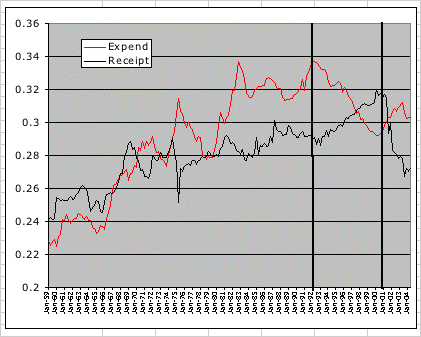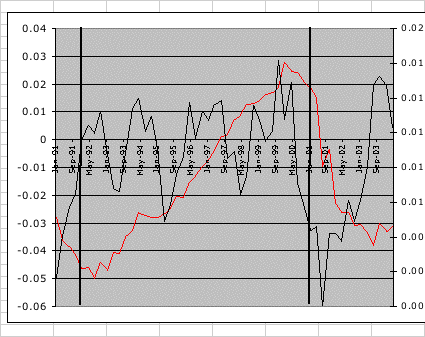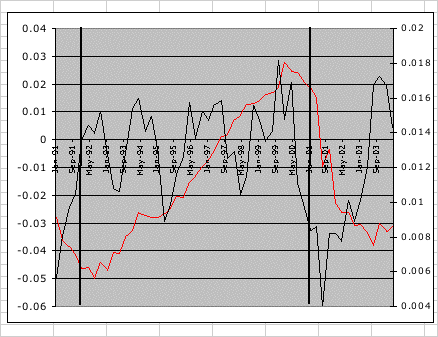[From Rick Marken (2004.09.14.1020)]
Well, since my previous post on the historical deficit/surplus was such a
big hit (well, it was in private posts to me) I thought I would show the
time course of the budget balance in terms of government expenditures and
receipts. The attached graph shows yearly government expenditures (Expend)
and receipts (Receipt), each as a proportion of GNP, since 1959. I have
marked the beginning of the Clinton and Bush II administrations with
vertical bars.
The Clinton period is interesting because there was actually a steady
decline in government spending, probably a result of reduction in the
defense budget due to the end of the Cold War, and a steady increase in
government receipts. That's why there was a surplus. The decline in
government expenditures could also be attributed to the fact that Clinton
had a Republican Congress from 1994 until the end of his term. But that
can't be the main reason for the decrease since expenditures started
increasing again as soon as Bush II came in, again with a Republican
Congress. Note also that, shortly after Bush II came in, well before 9/11
and right when the first tax cut was passed, receipts started to drop
precipitously. Also, note that the increase in receipts throughout the
Clinton administration cannot be attributed to Clinton's luck at having a
"booming" economy because the dot.com boom didn't start until 1997 at the
earliest while the linear increase in receipts starts in 1993.
I think what these data show is that who is president makes a difference to
the economy: presidents can control the economy, to some extent, via their
policies. They also show that, since Reagan, Republican presidents have led
the biggest increases in government spending of any presidents. The idea
that Republicans stand for small government is simply a myth. The data also
show (again) that presidential leadership has an easily detectable effect on
macroeconomic variables. This is particularly clear in the transition from
Clinton to Bush II. There is no sign at all, in 2000, just before Bush II
takes office, that the economy was "tanking" in terms of the deficit (or in
terms of growth). Expenditures were starting to level out or tick up a bit
and receipts had leveled out. The precipitous drop in receipts happens 2 or
3 months after Bush II takes office, well before 9/11. The increase in
spending during Bush II (with a Republican House and 50/50 Senate) continues
right on through to the end of 2003, but does decrease in 2004, probably
reflecting a reduction in spending on the war.
Best regards
Rick
Exp.jp2 (59.8 KB)
···
--
Richard S. Marken
MindReadings.com
Home: 310 474 0313
Cell: 310 729 1400
This email message is for the sole use of the intended recipient(s) and
may contain confidential information. Any unauthorized review, use,
disclosure or distribution is prohibited. If you are not the intended
recipient, please contact the sender by reply email and destroy all copies
of the original message.



